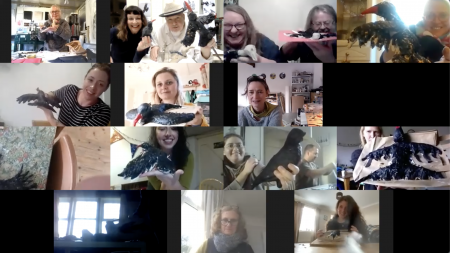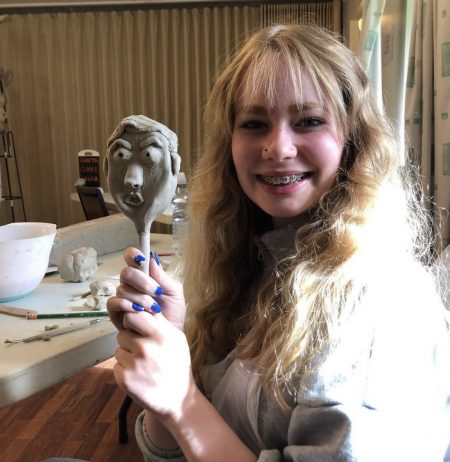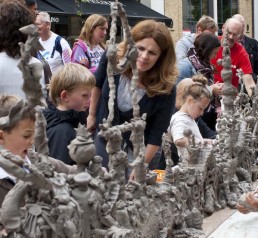Pandemic clay action!
Since 2007 we have engaged over 100,000 people in clay and making at events in around 14 UK cities (plus New York) through partnerships with communities, businesses, museums, galleries, libraries, schools, artists, waterways and so on. All with hands-on making by large numbers of people working side-by-side.
L to R: Clay Cargo at Ikon, Birmingham, 2013. Remake a Memory at Festival of Making, Blackburn, 2018.
Temporary Monument, London, 2015.
Images: Caroline Gervay and Clayground
But this was in pre-COVID times. How have we continued our practice over the last eighteen months when ways of engaging people in clay have had to change?
In early 2020, Clayground was shortlisted for The Whitegold International Prize devised to involve local communities in St Austell, a clay-quarrying town in Cornwall. Then the pandemic arrived and lockdown hit us all. Given all the uncertainties, rather than having two winners as planned, a partnership was jointly proposed to Whitegold with the three others shortlisted: Portland Inn Project, Grizedale Arts, and Francesca Anfossi. All agreed to work together and to reinvest the prize money back into the communities in Cornwall. Each artist or arts organisation was paired with one or two community organisations to develop a project with the theme of Convivial Clay – clay and food. Clayground’s Cornish partners are Edible St Austell, a social enterprise enabling food growing, and the St Blazey Recycle, Reuse, Resale CIC, a community venue promoting recycling, the circular economy and helping those on low incomes.
Clayground swiftly had to adapt our hands-on workshops to live online versions, communicating with partners and community participants we hadn’t even met in person. To cover all eventualities, we produced downloadable worksheets as well as pre-recorded demonstrations for participants who could not or did not wish to attend the online zoom workshops for a variety of reasons: lack of computer or internet, reticence about appearing online, or a lack of confidence about using zoom.
In February 2021, community members of Edible St Austell and the ceramic makers of the Clays and the Bay (CCB) project came together with Clayground’s Duncan Hooson and Claire West for Walk on the Wildside online workshops – a project to make in clay distinctive birds called choughs.
The chough features atop the crest of Cornwall’s coat of arms, beside a tin miner and a fisherman. Also known as the Crow of Cornwall, in the mid 1800s choughs suffered critical decline and finally vanished in 1973. Successful intervention by the RSPB and the Cornwall Chough Conservation Project resulted in a small influx of wild choughs in 2001. To highlight their fragility, Clayground devised a project to create raw clay choughs, made of white paper clay and embedded with seeds. The choughs’ distinctive red and black colouring was achieved through use of bio-degradable, recycled tissue paper applied directly to the damp clay. Participants were encouraged to place their completed choughs around Edible St Austell’s fruit trees in the town’s Linear Park. Designed to attract the attention of passers-by, the clay birds were left to gently decompose, providing both bird food and seed distribution.


Edible St Austell chough-making participants on zoom 2021. Duncan Hooson giving directions



Walk on the Wildside participants place their choughs in Linear Park
Images: James Darling

Vacant shop windows featuring Walk on the Wildside as part of the St Austell Green and Whitegold Festival, with Claire West and Duncan Hooson. Image: Clayground
Building trust under unusually distant circumstances has meant Clayground and its Cornish partners have had to adapt at the pace of the virus itself. Respecting our partner’s needs and realities has proved crucial to ensuring projects remained relevant, meaningful and purposeful. These principles of project co-design have meant learning from each other at every stage about motivations, constraints, capacities, schedules, numbers and much more.
With St Blazey Café we worked on a project called Histree, HerTree, TheirTree through a series of online sessions and a hands-on workshop day. The context of the project developed over time through discussion with Pauline Giles, BEM, Director of this community venue. A local through and through and ambassador for the St Blazey area, Pauline was keen to celebrate its history through personal memories of her community members, combining clay-making workshops with free lunch or tea for participants.
We had to be sensitive at all times to local challenges taking priority over online clay workshops. For example, provision of emergency food parcels to the St Blazey group meant one online workshop combined with a communal feast at the Café had to be cancelled. When the area was put under further restrictions, Pauline drove round herself delivering clay to individual families for a subsequent online workshop. Access to computer and broadband was patchy. Participation proved low but enthusiastic. A “long thin” venture emerged rather than the big shared making event originally planned for summer 2020. A sense of community was all the greater when we were finally able to meet in person for the culminating workshop in St Austell this summer.
Participants for both the chough-making with Edible St Austell and the history project with St Blazey Café used paper clay for their modelling. This was inspired by the historical use of china clay as a filler and pigment in paper manufacture. At Imerys, the primary clay quarrying operation in St Austell, 1.2 million tonnes of clay per annum are produced. Demand used to be dominated by paper production but with decline of use globally, only 25% now goes towards paper markets with shifts to other areas such as paints, pharmaceuticals, cosmetics, industrial ceramics and polymers.



Zoom session and in-person workshop at St Blazey Café, summer 2021. Duncan Hooson, Claire West and Laura West.
Pauline Giles, BEM, Director, St Blazey Café.




Participants in HisTree, HerTree, TheirTree and their creations. Images: Clayground
The Whitegold International Ceramics Prize culminated on 26th June 2021 with an event in the central town square of St Austell – the Green and Whitegold Festival. With the help of residents of St Blazey and St Austell, Clayground constructed a 4 metre high temporary raw clay Tree of Life. Forming the centrepiece, it comprised self-portraits by residents from the town and surroundings. Participants adhered to social distancing in clay-making ‘bubbles’. This meant Clayground worked with fewer members of the public than the thousands we normally engage. It meant however we spent more time with each participant – working in depth as opposed to breadth – with more time to listen to their individual stories (in spite of wearing masks!) as they each modelled their faces onto spoons with raw clay. The spoons were used as a nod to the theme of Conviviality – Clay and Food, the initial brief for the project. Clay for this public installation was generously sponsored by Potclays Ltd. All the reusable clay was reclaimed after the event and donated to local schools, artists and community groups.



Participants with their self-portraits at the Green and Whitegold Festival. Images: Clayground.


Self-portraits and the Clayground St Austell team, Laura, Duncan and Claire, with the completed Tree of Life.
As one participant commented on Instagram: “Great to see the town buzzing with activities yesterday. Sun shone too. Without doubt my favourite stand was the self portrait clay spoon heads. I could have stayed there all day – but children would have wept. It became more of a challenge to spot the real people characterised in clay mind you… simple pleasures.” @leezecrabbers
Clayground has taken great heart this year in continuing to work with clay and communities, albeit in smaller numbers and in new ways. We look forward to our relationships with Duana Pearson, Edible St Austell, and Pauline Giles, St Blazey Café, being sustained with more projects to follow. There is so much potential in developing ideas by thinking and learning together through clay – it will be interesting to see how the Whitegold Prize for socially engaged practice develops over time and how there can be long-lasting impact for local communities.
We’ll post more news soon of another project we’ve been busy with over the summer, this time in North London. We’re working to restore a Roman kiln to its original site in Highgate Wood with a ceramics workshop as a focus for community engagement and learning.
-
Pandemic clay action!
18th Aug 21
-
The Volcano and the Microbes: interaction between geology and biology
4th Jun 21
-
Perseverance: a new NASA rover continues to follow Martian clay
2nd Aug 20
-
Research into clay provides clues as to how much water there was on Mars
18th Sep 19
-
22 Hands: British Ceramics Biennial Commission
12th Aug 19
-
Clayground Summer Events
24th Jun 19
-
Colourful Clays on Mars
20th Feb 19
Thames foreshore fragments and visual references
4th Dec 12
How is clay formed? Is it inorganic or organic?
10th Sep 12
CLAY FROM AROUND THE WORLD
3rd Aug 11
Clay Cargo 2014 Collection: the Thames Foreshore
15th Dec 14
Clues to life on Mars likely to be found in clays, Javier Cuadros
5th Aug 16
Clay Cargo 2013-2015
15th Jun 15
Sessions on the Clay Cargo boat, hosted by Fordham Gallery
9th Mar 15
Civic Spaces, Exhibitions
Museums and Galleries, Regeneration
Maker spaces, Rural Sites
Archaeology
Youth and Adult Community Groups, Professionals
Art Groups, Families, Students
Collaborations, Archaeology Sheets
Commissions, Thinking Hands? Research
Knowledge Exchange









